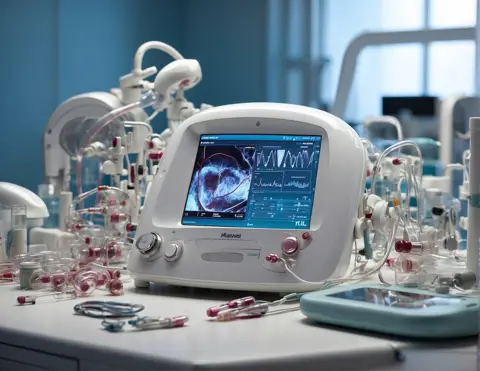
Omar Aimer
ISoP EC Member and Co-lead of the Medical Device Safety SIG

From software updates to complex human-machine interactions, medical devices pose safety challenges that require dedicated frameworks beyond drug vigilance.
When considering patient safety, medicines often take centre stage, while medical devices, the machines, implants, software, and diagnostic tools that are increasingly integral to healthcare, receive less focused attention. Yet, these devices are as vital to patient outcomes as pharmaceuticals, and ensuring their safety demands a distinct and equally robust approach.
Uppsala Reports has previously highlighted various perspectives on medical device safety, ranging from regulatory challenges to patient experiences. Since those discussions, the field has seen important regulatory reforms and technological advances, alongside growing public awareness. However, many challenges persist, calling for renewed global attention and innovation.
Medical devices differ fundamentally from medicines in how they interact with patients and healthcare systems. Devices often involve complex human-machine interactions, software updates, and variable usage environments, all contributing to evolving safety profiles. Unlike medicines, regulatory approval processes for devices frequently require less extensive pre-market clinical evidence. Moreover, safety issues may stem not only from the device itself but also from its deployment, modifications, or user handling after approval.
Devices evolve continuously: software can be updated remotely, new functionalities added, or devices repurposed. These dynamics introduce safety concerns that traditional adverse event reporting systems, primarily designed for medicines, struggle to capture effectively. Consequently, medical device safety requires dedicated methodologies, language, and regulatory frameworks tailored to these unique characteristics.
The introduction of regulations such as the European Union’s Medical Device Regulation (MDR) and In Vitro Diagnostic Regulation (IVDR) has significantly reshaped expectations for device surveillance in many regions. Meanwhile, agencies like the U.S. Food and Drug Administration have enhanced their use of real-world data and issued specific guidance addressing cybersecurity and software-as-a-medical-device concerns.
Despite these advancements, implementation across countries remains uneven. Many low- and middle-income countries continue to face challenges in establishing robust post-market surveillance systems, often relying on voluntary reporting mechanisms with limited analytical capacity. The COVID-19 pandemic further underscored these disparities, revealing gaps especially in monitoring rapidly deployed diagnostic and respiratory devices.
This patchwork of regulatory maturity and surveillance capability highlights the urgent need for increased international collaboration and harmonisation to protect patients worldwide.

Underreporting of device-related adverse events remains a significant hurdle globally. Differences in definitions and reporting standards: for example, what constitutes a “malfunction” or “serious incident” complicates data consistency. Moreover, integration of device safety data across different surveillance platforms and jurisdictions is often lacking, impeding comprehensive safety signal detection.
Structural issues exacerbate these technical challenges. Many regulatory bodies lack sufficient resources and trained personnel to manage device safety effectively. Additionally, healthcare providers frequently receive minimal training on device vigilance, reducing awareness and reporting of device-related harms.
Addressing these challenges calls for strengthened cooperation among national regulators, regional networks, global organisations such as the World Health Organization, forums like the International Medical Device Regulators Forum, and professional societies, including the International Society of Pharmacovigilance (ISoP). Within ISoP, the Medical Device Safety Special Interest Group (SIG) plays a vital role in advancing knowledge, promoting best practices, and fostering global collaboration on medical device vigilance.
Simultaneously, emerging technologies like artificial intelligence, machine learning, and patient-centred reporting tools offer promising avenues for enhancing real-time safety monitoring and signal detection. However, technology alone is not enough. A cultural shift is essential, one that recognises medical device safety as a specialised field deserving focused attention and dedicated resources, rather than an adjunct to drug safety. This shift involves valuing patient and user input, developing tailored training programs for healthcare professionals, and fostering adaptable regulatory frameworks that can keep pace with rapidly evolving device technologies.
Medical devices are transforming healthcare delivery by offering unprecedented benefits, but they are also introducing new risks. The global pharmacovigilance community, including networks like ISoP and its Medical Device Safety SIG, must rise to the challenge of integrating device safety into mainstream patient protection efforts with renewed vigour.
By embracing collaborative, innovative, and patient-centred approaches, the world can build safer systems that ensure these essential technologies fulfil their promise without compromising patient wellbeing.
Despite focusing on different species, human and veterinary pharmacovigilance share many goals and approaches, offering opportunities for mutual enhancement of the two disciplines.
06 November 2025
Counterfeit drugs threaten millions worldwide, yet healthcare workers often lack training to spot fakes or report them, leaving this problem largely invisible.
01 October 2025
Safety systems do not need to be complex to be effective. Shanthi Pal explains the thinking behind the Global Smart Pharmacovigilance Strategy, and how it can be implemented.
17 December 2025